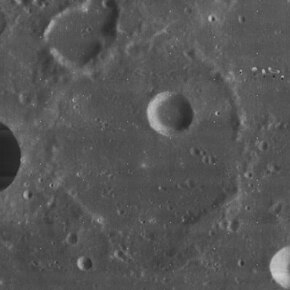Chevallier (crater)
 Lunar Orbiter 4 image | |
| Coordinates | 45°01′N 51°34′E / 45.01°N 51.57°E |
|---|---|
| Diameter | 51.83 km (32.21 mi) |
| Depth | 1.2 km |
| Colongitude | 309° at sunrise |
| Eponym | Temple Chevallier |

Chevallier is a lunar impact crater that is located in the northeastern part of the Moon's near side, about a crater diameter east-southeast of the prominent crater Atlas. To the south-southeast of Chevallier is the flooded crater Shuckburgh. Chevallier was named by the IAU in 1935.[1]
This formation is little more than a disintegrated crater rim protruding upward slightly from a lava-flooded surface. All that survives of this feature is a few arcing sections of low ridges in the surface. The most prominent section of rim is along the northeast where it has merged with a smaller double-crater formation which has also been flooded. The interior floor has been resurfaced by the flows of lava, which are joined to the nearby flooded terrain. In the eastern half of the floor is Chevallier B, a small, partly flooded crater.
Just to the west of the rim of Chevallier is Atlas A, a sharp-rimmed, bowl-shaped crater. To the east is Lacus Temporis.
Satellite craters
[edit]By convention these features are identified on lunar maps by placing the letter on the side of the crater midpoint that is closest to Chevallier.
| Chevallier | Latitude | Longitude | Diameter |
|---|---|---|---|
| B | 45.2° N | 51.9° E | 13 km |
| F | 46.1° N | 56.5° E | 9 km |
| K | 43.5° N | 50.9° E | 6 km |
| M | 46.0° N | 51.2° E | 16 km |
References
[edit]- ^ "Chevallier". Gazetteer of Planetary Nomenclature. IAU/NASA/USGS. Retrieved 26 April 2024.
Sources
[edit]- Andersson, L. E.; Whitaker, E. A. (1982). NASA Catalogue of Lunar Nomenclature. NASA RP-1097.
- Blue, Jennifer (July 25, 2007). "Gazetteer of Planetary Nomenclature". USGS. Retrieved 2007-08-05.
- Bussey, B.; Spudis, P. (2004). The Clementine Atlas of the Moon. New York: Cambridge University Press. ISBN 978-0-521-81528-4.
- Cocks, Elijah E.; Cocks, Josiah C. (1995). Who's Who on the Moon: A Biographical Dictionary of Lunar Nomenclature. Tudor Publishers. ISBN 978-0-936389-27-1.
- McDowell, Jonathan (July 15, 2007). "Lunar Nomenclature". Jonathan's Space Report. Retrieved 2007-10-24.
- Menzel, D. H.; Minnaert, M.; Levin, B.; Dollfus, A.; Bell, B. (1971). "Report on Lunar Nomenclature by the Working Group of Commission 17 of the IAU". Space Science Reviews. 12 (2): 136–186. Bibcode:1971SSRv...12..136M. doi:10.1007/BF00171763. S2CID 122125855.
- Moore, Patrick (2001). On the Moon. Sterling Publishing Co. ISBN 978-0-304-35469-6.
- Price, Fred W. (1988). The Moon Observer's Handbook. Cambridge University Press. ISBN 978-0-521-33500-3.
- Rükl, Antonín (1990). Atlas of the Moon. Kalmbach Books. ISBN 978-0-913135-17-4.
- Webb, Rev. T. W. (1962). Celestial Objects for Common Telescopes (6th revised ed.). Dover. ISBN 978-0-486-20917-3.
- Whitaker, Ewen A. (1999). Mapping and Naming the Moon. Cambridge University Press. ISBN 978-0-521-62248-6.
- Wlasuk, Peter T. (2000). Observing the Moon. Springer. ISBN 978-1-85233-193-1.

